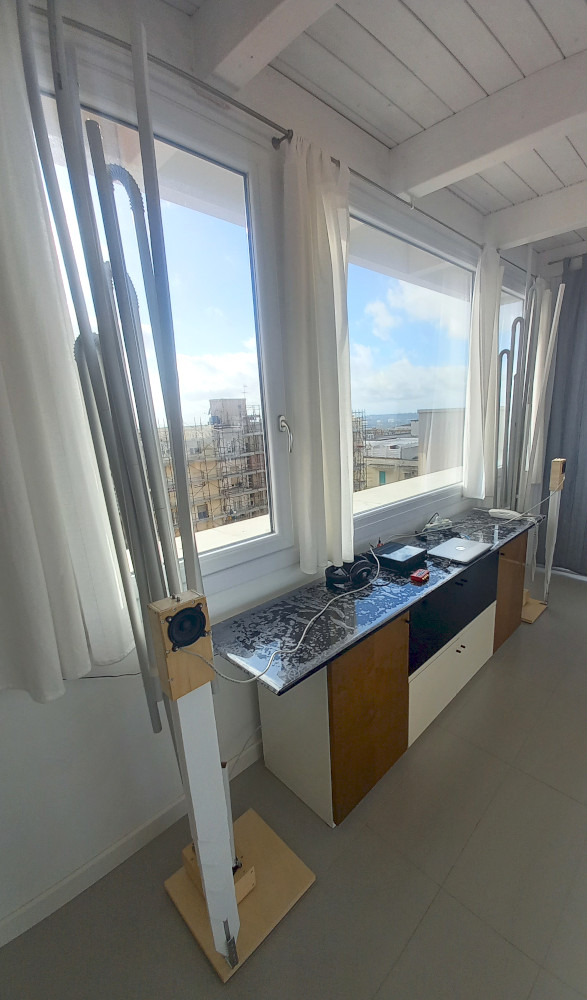
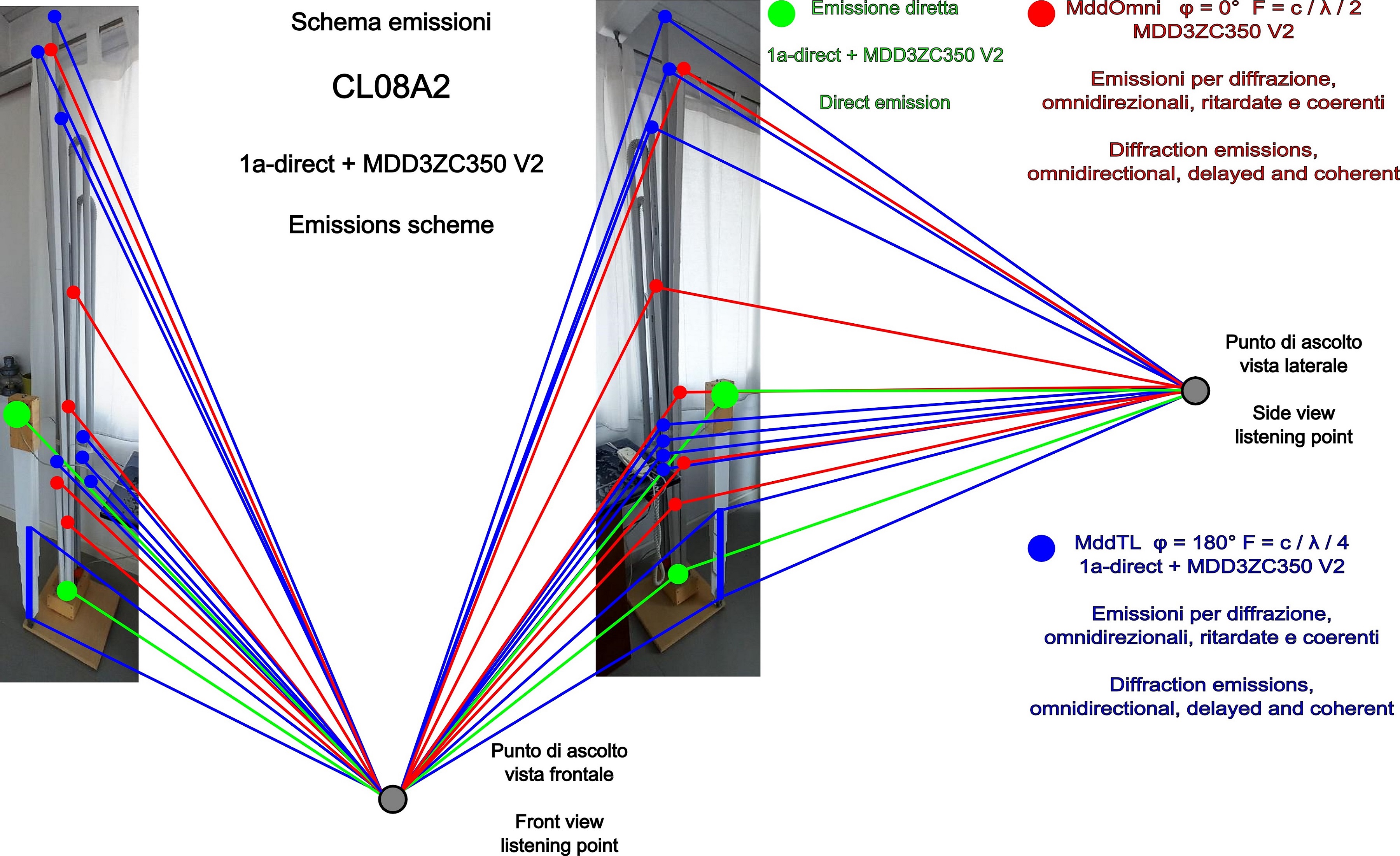
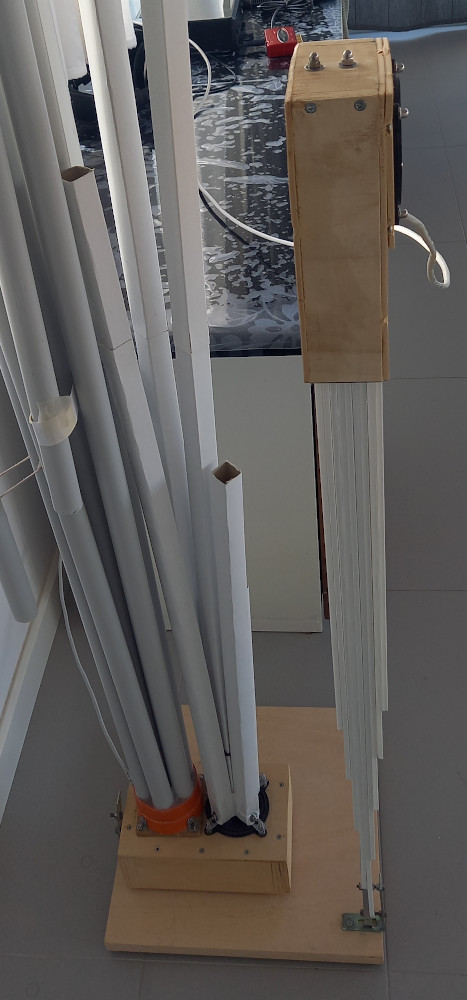
CL08A2 (2024 02) - home



CL - Firma, progetto audio di Claudio Gandolfi, 08 - Diametro driver 3FE25 Faital-Pro, 8 cm, A2 - Codice progetto, doppio 3FE25 full range, quintupla emissione: 2 x diretta, 1 x omnidirezionale, 2 x multiTL.
CL - Signature, audio project by Claudio Gandolfi,
08 - 3FE25 Faital-Pro driver diameter, 8 cm,
A2 - Project code, double 3FE25 full range, quintuple emission: 2 x direct, 1 x omnidirectional, 2 x multiTL.
Le caratteristiche dell'ambiente d'ascolto sono molto importanti per la qualità della riproduzione. Con la tecnologia MDD si usa una parte dell'energia emessa dagli altoparlanti per generare fronti sonori secondari, i fronti sferici generati per diffrazione sono coerenti, ritardati e ottimizzano l'interazione con la stanza. Le emozioni prodotte dall'ascolto della musica registrata si possono ottenere anche senza trattare acusticamente il locale e con economici altoparlanti larga-banda. MDD Multi Delays Diffraction. Le emissioni multiple simulano sorgenti sonore tridimensionali, i ritardi ottimizzano l'ascolto in ambienti non trattati acusticamente, la diffrazione rende l'altoparlante omnidirezionale a tutte le frequenze.
The characteristics of the listening environment are very important for the quality of playback. With MDD technology, part of the energy emitted by the speakers is used to generate secondary sound fronts, the spherical fronts generated by diffraction are coherent, delayed and optimize interaction with the room. The emotions produced by listening to recorded music can also be obtained without treating the room acoustically and with economical broadband speakers. MDD Multi Delays Diffraction. The multiple emissions simulate three-dimensional sound sources, the delays optimize listening in environments that are not acoustically treated, the diffraction makes the speaker omnidirectional at all frequencies.
I carichi acustici sono realizzati con guide d'onda multiple. Ogni singola guida d'onda aggiunge onde secondarie ritardate e coerenti a tutti i suoni anche se la registrazione è stata fatta con microfoni posizionati in punti non ideali. Le onde primarie e quelle secondarie sono riflesse dall'ambiente e arrivano all'ascoltatore che le percepisce come compatibili con una sorgente tridimensionale presente nella stanza. L'emissione omnidirezionale in un ambiente riflettente aumenta l'effetto delle onde riflesse dal locale d'ascolto. Quando si riproducono le riflessioni della sala di registrazione per l'effetto Haas il cervello percepisce queste ultime come una prosecuzione dei segnali precedenti. La successione: onda primaria, onde secondarie coerenti e ritardate, riflessioni del locale d'ascolto, riflessioni della sala di registrazione diventano per il cervello un unico suono più facile da interpretare e piacevole da ascoltare. Diminuisce il tempo necessario alla memoria per decodificare i suoni e aumenta il tempo a disposizione della fantasia. La riproduzione è simile all'ascolto dal vivo degli strumenti nella propria stanza. Non sono le condizioni di massima fedeltà alla registrazione originale ma può essere molto divertente. La zona d'ascolto è ampia e si può seguire al meglio la musica in ogni punto della stanza.
The acoustic loads are made with multiple waveguides. Each individual waveguide adds delayed, coherent secondary waves to all sounds even if the recording was made with microphones positioned in less than ideal locations. The primary and secondary waves are reflected by the environment and reach the listener who perceives them as compatible with a three-dimensional source present in the room. Omnidirectional emission in a reflective environment increases the effect of the waves reflected from the listening room. When the reflections of the recording room are reproduced due to the Haas effect, the brain perceives them as a continuation of the previous signals. The succession: primary wave, coherent and delayed secondary waves, reflections from the listening room, reflections from the recording room become a single sound for the brain that is easier to interpret and pleasant to listen to. It decreases the time needed for memory to decode sounds and increases the time available for imagination. Playback is similar to listening to instruments live in your room. It's not the most faithful conditions to the original recording but it can be a lot of fun. The listening area is large and you can better follow the music from every point of the room.
link - home
- MDD Multi Delays Diffraction
- mddOmni
- 3D effect
- anti Haas effect
- diffrattore acustico omnidirezionale - omnidirectional acoustic diffractor
- psicoacustica - psychoacoustics
- mddOmni diy
- mddTL
- cabinet neutro - neutral cabinet
- logarithmic sum
- mddTL diy
- supporto a risonanza subsonica - subsonic resonance support
- base asimmetrica - asymmetric base
- 3FE25
- stereo
CL08A2 - home
Il progetto usa i prototipi 1a-direct (oltre 100 guide d'onda) e MDD3ZC350 V2 (5 + 7 guide d'onda), ogni canale ha due driver 3FE25 della Faital-Pro collegati in serie. Il driver 3FE25 del prototipo 1a-direct ha una emissione frontale diretta e una posteriore con linee di trasmissione multiple mddTL. Il driver 3FE25 del prototipo MDD3ZC350 V2 ha una emissione parziale frontale diretta, una frontale omnidirezionale multipla mddOmni e una emissione posteriore con linee di trasmissione multiple mddTL.
The project uses the 1a-direct (over 100 waveguides) and MDD3ZC350 V2 prototypes ( 5 + 7 waveguides), each channel has two Faital-Pro 3FE25 drivers connected in series. The 3FE25 driver of the 1a-direct prototype has direct front output and rear output with multiple mddTL transmission lines. The 3FE25 driver of the MDD3ZC350 V2 prototype has a direct front partial emission, a multiple omnidirectional front mddOmni and a rear emission with multiple transmission lines mddTL.
La singola guida d'onda fraziona l'energia sonora emessa dei coni dei driver, la isola dall'ambiente d'ascolto, la trasporta in posizioni distanti dal driver, la riemette nell'ambiente con un ritardo e mantenendo la coerenza con l'emissione primaria del driver. La dimensione di uscita delle guide d'onda è di 1 - 2 cm quindi per effetto della diffrazione acustica si generano fronti sonori di forma sferica fino a quasi 20 KHz.
The single waveguide fractions the sound energy emitted by the driver cones, isolates it from the listening environment, transports it to positions distant from the driver, re-emits it into the environment with a delay and maintaining coherence with the emission primary of the driver. The output size of the waveguides is 1 - 2 cm therefore, due to the effect of acoustic diffraction, spherical sound fronts are generated up to almost 20 KHz.
La qualità sonora è ottima ma la realizzazione è complessa. Ci sono molti componenti, le guide d'onda montate con leve meccanicamente svantaggiose che possono generare vibrazioni indesiderate peggiorando la riproduzione. La camere di compressione delle guide d'onda deve essere a tenuta d'aria per non ridurre la risposta alle basse frequenze. Non è un progetto adatto per chi vuole iniziare con il DIY. Sto già pensando un nuovo progetto con le stesse caratteristiche audio ma più semplice da realizzare.
The sound quality is excellent but the implementation is complex. There are many components, waveguides mounted with mechanically disadvantageous levers that can generate unwanted vibrations worsening reproduction. The compression chambers of the waveguides must be airtight so as not to reduce the low frequency response. It is not a suitable project for those who want to start with DIY. I'm already thinking of a new project with the same audio characteristics but simpler to make.
dominio del tempo - time domain - home
Dal punto di ascolto si vedono decine di punti di emissione omnidirezionali, i fronti sonori generati in punti diversi dello spazio arrivano direttamente senza riflessioni. Nella tecnologia MDD (Multi Delays Diffraction) le emissioni multiple, coerenti, ritardate e omnidirezionali rendono tridimensionale la scena sonora, mascherano gli effetti indesiderati delle riflessioni della stanza di ascolto.
From the listening point you can see dozens of omnidirectional emission points, the sound fronts generated at different points in the space arrive directly without reflections. In MDD (Multi Delays Diffraction) technology, multiple, coherent, delayed and omnidirectional emissions make the sound scene three-dimensional, masking the unwanted effects of reflections in the listening room.

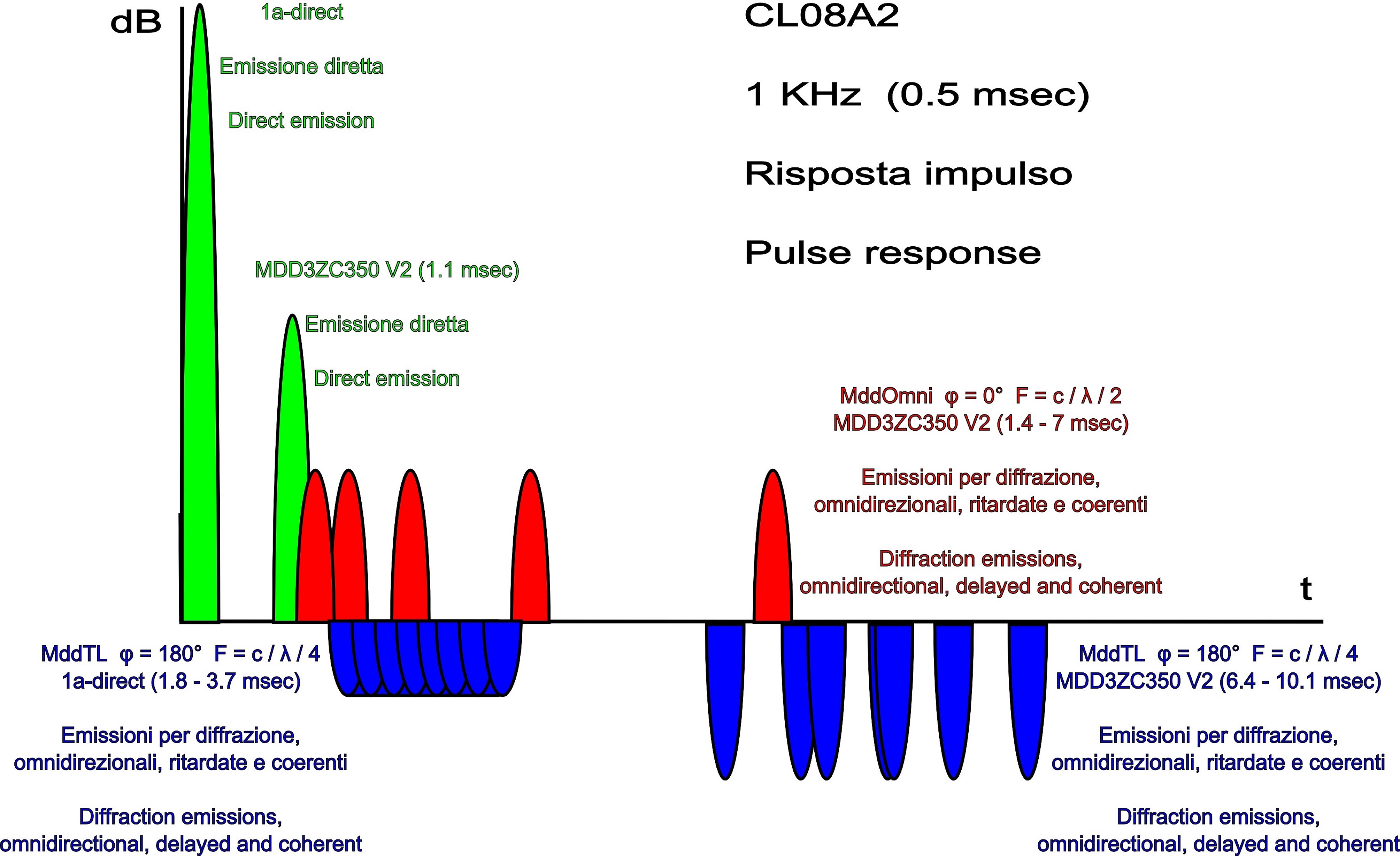
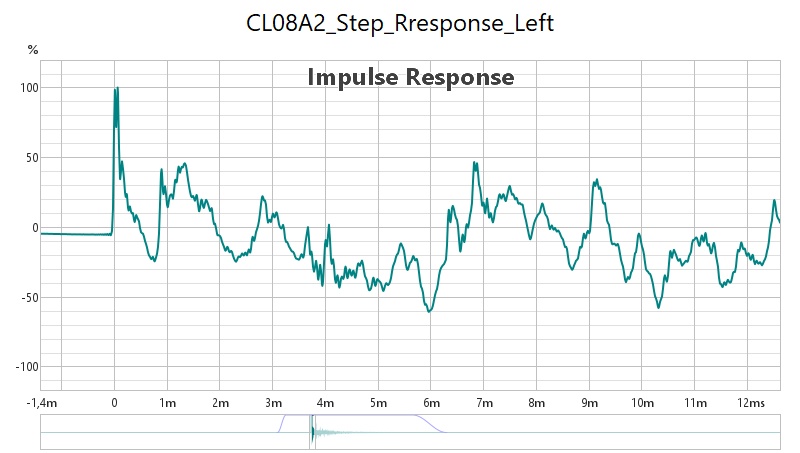
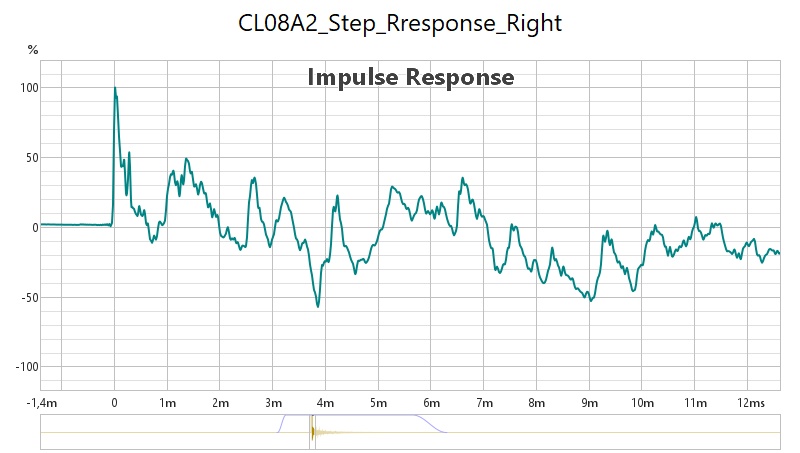 Dai grafici della risposta allo step si può intuire la complessità del segnale acustico emesso dalla coppia di prototipi 1a-direct, MDD3ZC350 V2. I grafici delle misure sono ulteriormente complicati dalla presenza di riflessioni. Nel disegno della risposta teorica considero un impulso fatto da una sola semionda a 1KHz (0.5 msec), per semplicità trascuro le riflessioni e suppongo che tutte le guide d'onda abbiano una risposta in frequenza piatta, l'asse del tempo è realistico, i valori delle ampiezze sono indicativi per un'analisi qualitativa.
Dai grafici della risposta allo step si può intuire la complessità del segnale acustico emesso dalla coppia di prototipi 1a-direct, MDD3ZC350 V2. I grafici delle misure sono ulteriormente complicati dalla presenza di riflessioni. Nel disegno della risposta teorica considero un impulso fatto da una sola semionda a 1KHz (0.5 msec), per semplicità trascuro le riflessioni e suppongo che tutte le guide d'onda abbiano una risposta in frequenza piatta, l'asse del tempo è realistico, i valori delle ampiezze sono indicativi per un'analisi qualitativa.
From the step response graphs you can understand the complexity of the acoustic signal emitted by the pair of prototypes 1a-direct, MDD3ZC350 V2. The measurement graphs are further complicated by the presence of reflections. In the theoretical response design I consider an impulse made by a single half-wave at 1KHz (0.5 msec), for simplicity I neglect the reflections and assume that all waveguides have a flat frequency response, the time axis is realistic, the Amplitude values are indicative for a qualitative analysis.
1. Il primo impulso sonoro (verde) che arriva nel punto di ascolto è quello emesso dal prototipo 1a-direct. Il driver 3FE25 è posizionato circa a 1 metro di altezza. 2. Il secondo impulso sonoro (verde) è ritardato di circa 1.1 millisecondi e arriva in fase con ampiezza ridotta. È emesso dal driver del prototipo MDD3ZC350 V2. L'ampiezza è ridotta perché parte dell'energia sonora emessa è inviata all'interno del carico acustico frontale mddOmni.
1. The first sound impulse (green) that arrives at the listening point is the one emitted by the 1a-direct prototype. The 3FE25 driver is positioned approximately 1 meter high. 2. The second sound pulse (green) is delayed by approximately 1.1 milliseconds and arrives in phase with reduced amplitude. It is issued by the prototype driver MDD3ZC350 V2. The amplitude is reduced because part of the sound energy emitted is sent inside the mddOmni frontal acoustic load.
3. Segue una serie di cinque impulsi sonori (rosso). Gli impulsi sono in fase con il primo, sono coerenti e con ritardi progressivi tra 1.4 e 7 millisecondi, l'ampiezza è ridotta. È l'emissione omnidirezionale multipla dal carico frontale mddOmni del prototipo MDD3ZC350 V2.
3. A series of five sound pulses (red) follows. The pulses are in phase with the first, they are coherent and with progressive delays between 1.4 and 7 milliseconds, the amplitude is reduced. It is the multiple omnidirectional emission from the mddOmni front load of the MDD3ZC350 V2 prototype.
4. Contemporaneamente arriva una serie 180 impulsi sonori (blu) emessi dal carico acustico mddTL del prototipo 1a-direct. Gli impulsi sono in controfase, sono coerenti e con ritardi progressivi tra 1.8 e 3.7 millisecondi, l'ampiezza è ulteriormente ridotta. 5. Successivamente nel punto di ascolto arriva una serie di sette impulsi sonori (blu). Gli impulsi sono in controfase rispetto al primo, sono coerenti e con ritardi progressivi tra 7 e 10 millisecondi, l'ampiezza è simile a quella degli impulsi emessi dal carico acustico mddOmni. È l'emissione dal carico posteriore mddTL del prototipo MDD3ZC350 V2
4. At the same time, a series of 180 sound pulses (blue) arrives emitted by the mddTL acoustic load of the 1a-direct prototype. The pulses are in counter-phase, they are coherent and with progressive delays between 1.8 and 3.7 milliseconds, the amplitude is further reduced. 5. Next, a series of seven sound pulses (blue) arrives at the listening point. The pulses are in counter-phase with respect to the first, they are coherent and with progressive delays between 7 and 10 milliseconds, the amplitude is similar to that of the pulses emitted by the mddOmni acoustic load. It is the output from the mddTL rear load of the MDD3ZC350 V2 prototype.
Tutti gli impulsi sonori generati sono sincronizzati, sono emessi dai due driver collegati in serie e attraversati dalla stessa corrente elettrica, le forze che agiscono sui coni sono proporzionali alla corrente. Gli impulsi ritardati emessi per diffrazione dalle guide d'onda di mddOmni e mddTL sono coerenti con l'emissione del driver, i ritardi dipendono solo dalla lunghezza delle guide d'onda.
All the sound impulses generated are synchronized, they are emitted by the two drivers connected in series and crossed by the same electric current, the forces acting on the cones are proportional to the current. The delayed pulses emitted by diffraction from the mddOmni and mddTL waveguides are consistent with the emission of the driver, the delays depend only on the length of waveguides.
 La tecnologia MDD genera fronti sonori coerenti e ritardati per simulare la presenza dello strumento riprodotto all'interno della stanza d'ascolto. Uno strumento emette nello stesso istante più fronti sonori in punti diversi dello spazio che raggiungono le orecchie dell'ascoltatore in momenti diversi. Con la tecnologia MDD i punti di emissione multipli di onde secondarie simulano un volume virtuale dello strumento riprodotto, anche questo facilita il riconoscimento del suono emesso in qualunque punto della stanza d'ascolto. Si ha un effetto 3D generato dalla distribuzione delle uscite delle guide d'onda nelle direzioni ortogonali dei tre assi X, Y e Z. L'impostazione è alternativa all'emissione con sorgente puntiforme che ottimizza l'ascolto in un'area limitata e in stanze trattate acusticamente.
La tecnologia MDD genera fronti sonori coerenti e ritardati per simulare la presenza dello strumento riprodotto all'interno della stanza d'ascolto. Uno strumento emette nello stesso istante più fronti sonori in punti diversi dello spazio che raggiungono le orecchie dell'ascoltatore in momenti diversi. Con la tecnologia MDD i punti di emissione multipli di onde secondarie simulano un volume virtuale dello strumento riprodotto, anche questo facilita il riconoscimento del suono emesso in qualunque punto della stanza d'ascolto. Si ha un effetto 3D generato dalla distribuzione delle uscite delle guide d'onda nelle direzioni ortogonali dei tre assi X, Y e Z. L'impostazione è alternativa all'emissione con sorgente puntiforme che ottimizza l'ascolto in un'area limitata e in stanze trattate acusticamente.
MDD technology generates coherent and delayed sound fronts to simulate the presence of the instrument being played inside the listening room. An instrument emits multiple sound fronts at different points in space at the same time which reach the listener's ears at different times. With MDD technology, the multiple emission points of secondary waves simulate a virtual volume of the instrument being reproduced, this also facilitates the recognition of the sound emitted at any point in the listening room. There is a 3D effect generated by the distribution of the waveguide outputs in the orthogonal directions of the three axes X, Y and Z. The setting is an alternative to emission with a point source which optimizes listening in a limited area and acoustically treated rooms.
L'effetto Haas (precedenza) si manifesta quando due suoni identici arrivano all'orecchio in successione. Con ritardi superiori a 5 millisecondi con suoni semplici (click) l'udito percepisce suoni distinti. Con suoni più complessi il tempo sale a 40 millisecondi. I punti di emissione del carico acustico mddOmni si trovano a distanze crescenti dal driver e i fronti sonori hanno ritardi compresi fra 1 e 10 millisecondi. La successione dei fronti sonori impedisce l'attivazione dell'effetto Haas, un evento non può essere percepito come due suoni distinti.
The Haas effect (precedence) occurs when two identical sounds arrive at the ear in succession. With delays greater than 5 milliseconds with simple sounds (clicks) the ear perceives distinct sounds. With more complex sounds the time increases to 40 milliseconds. The emission points of the mddOmni acoustic load are located at increasing distances from the driver and the sound fronts have delays between 1 and 10 milliseconds. The succession of sound fronts prevents the activation of the Haas effect, an event cannot be perceived as two distinct sounds.

 Usare la tecnologia MDD equivale a ricoprire le pareti riflettenti con pannelli diffrattori, si moltiplicano i possibili percorsi dell'energia acustica tra altoparlante e punto d'ascolto. La tecnologia MDD è utilizzabile anche in ambienti d'ascolto molto riflettenti. I ritardi ottimizzano l'ascolto in ambienti non trattati acusticamente, è lo stesso effetto che si ottiene con l'applicazione alle pareti di diffrattori passivi. Le guide d'onda generano ritardi compresi fra 0 e 10 millisecondi, l'inviluppo delle emissioni si espande (dura più a lungo nel punto d'ascolto) e le riflessioni sono percepite come generate dalla stessa origine, la fatica d'ascolto diminuisce e il riconoscimento dei suoni è più facile. L'emissione omnidirezionale con la moltiplicazione dei possibili percorsi e riduce ulteriormente la possibilità di attivazione dell'effetto precedenza.
Usare la tecnologia MDD equivale a ricoprire le pareti riflettenti con pannelli diffrattori, si moltiplicano i possibili percorsi dell'energia acustica tra altoparlante e punto d'ascolto. La tecnologia MDD è utilizzabile anche in ambienti d'ascolto molto riflettenti. I ritardi ottimizzano l'ascolto in ambienti non trattati acusticamente, è lo stesso effetto che si ottiene con l'applicazione alle pareti di diffrattori passivi. Le guide d'onda generano ritardi compresi fra 0 e 10 millisecondi, l'inviluppo delle emissioni si espande (dura più a lungo nel punto d'ascolto) e le riflessioni sono percepite come generate dalla stessa origine, la fatica d'ascolto diminuisce e il riconoscimento dei suoni è più facile. L'emissione omnidirezionale con la moltiplicazione dei possibili percorsi e riduce ulteriormente la possibilità di attivazione dell'effetto precedenza.
Using MDD technology is equivalent to covering the reflecting walls with diffracting panels, the possible paths of the acoustic energy between the loudspeaker and the listening point are multiplied. MDD technology can also be used in highly reflective listening environments. The delays optimize listening in environments that are not acoustically treated, it is the same effect that is obtained by applying passive diffractors to the walls.The waveguides generate delays between 0 and 10 milliseconds, the envelope of the emissions expands (lasts longer at the listening point) and the reflections are perceived as being generated by the same origin, the fatigue of listening decreases and the recognition of sounds is easier. Omnidirectional emission with the multiplication of possible paths and further reduces the possibility of activating the precedence effect.
dominio delle frequenze - frequency domain - home
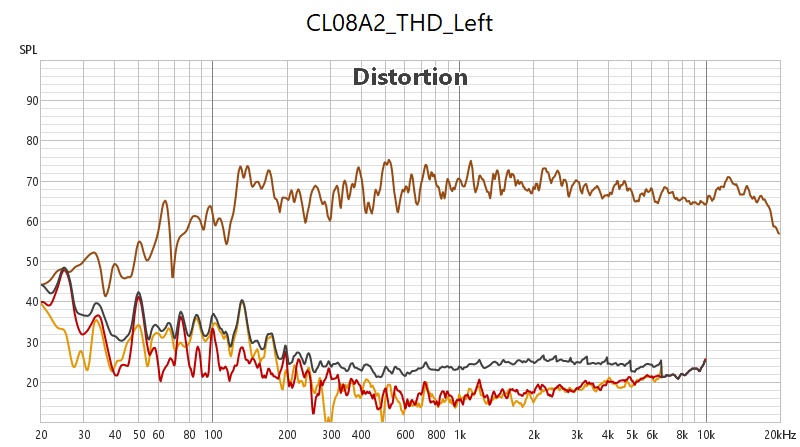
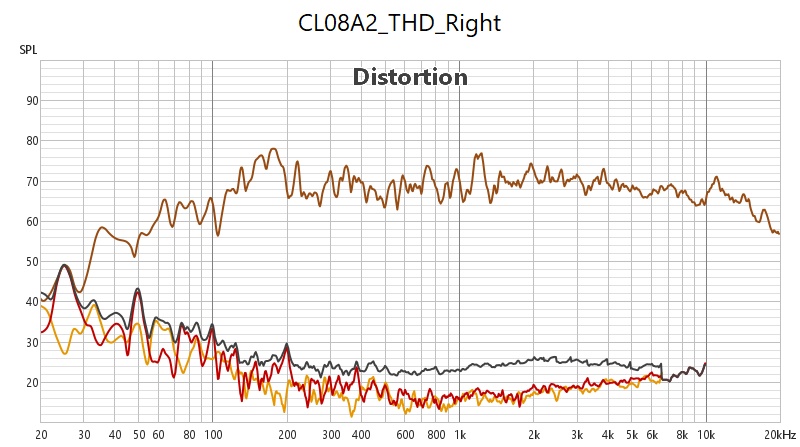
Il prototipo 1a-direct aumenta il livello delle alte frequenze nel punto di ascolto. Nel prototipo MDD3ZC350 V2 l'energia sonora alle alte frequenze è emessa dal driver 3FE25 in un lobo frontale, il carico acustico mddOmni la ridistribuisce su 360 gradi riducendone la pressione sonora. Con il prototipo 1a-direct le alte frequenze si sentono bene anche livelli sonori ridotti rispetto al solo prototipo MDD3ZC350 V2.
The 1a-direct prototype increases the level of high frequencies at the listening point. In the prototype MDD3ZC350 V2 the sound energy at high frequencies is emitted by the 3FE25 driver in a frontal lobe, the mddOmni acoustic load redistributes it over 360 degrees, reducing the sound pressure . With the 1a-direct prototype, high frequencies can be heard well even at reduced sound levels compared to the MDD3ZC350 V2 prototype alone.
Il prototipo MDD3ZC350 V2 riproduce meglio le basse frequenze sotto i 100 Hz rispetto al prototipo 1a-direct. In entrambi i prototipi è usata le tecnologia del cabinet neutro.
The MDD3ZC350 V2 prototype reproduces low frequencies below 100 Hz better than the 1a-direct prototype. In both prototypes the technology of the neutral cabinet is used.
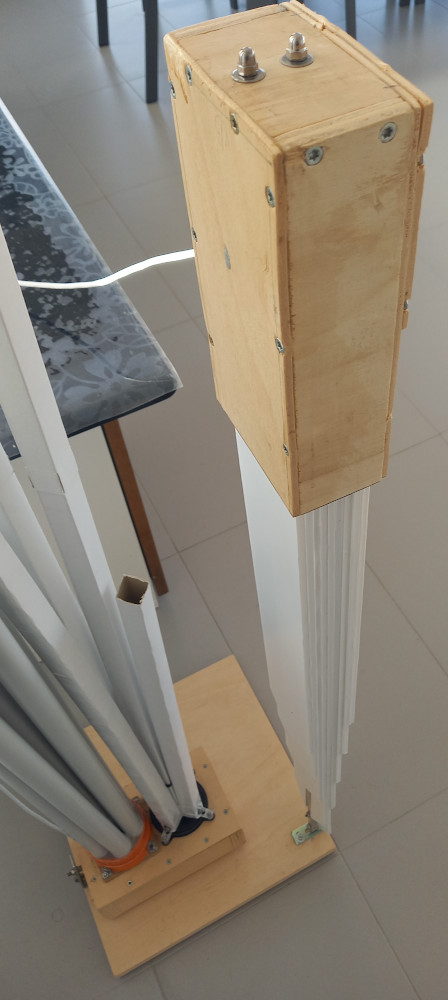
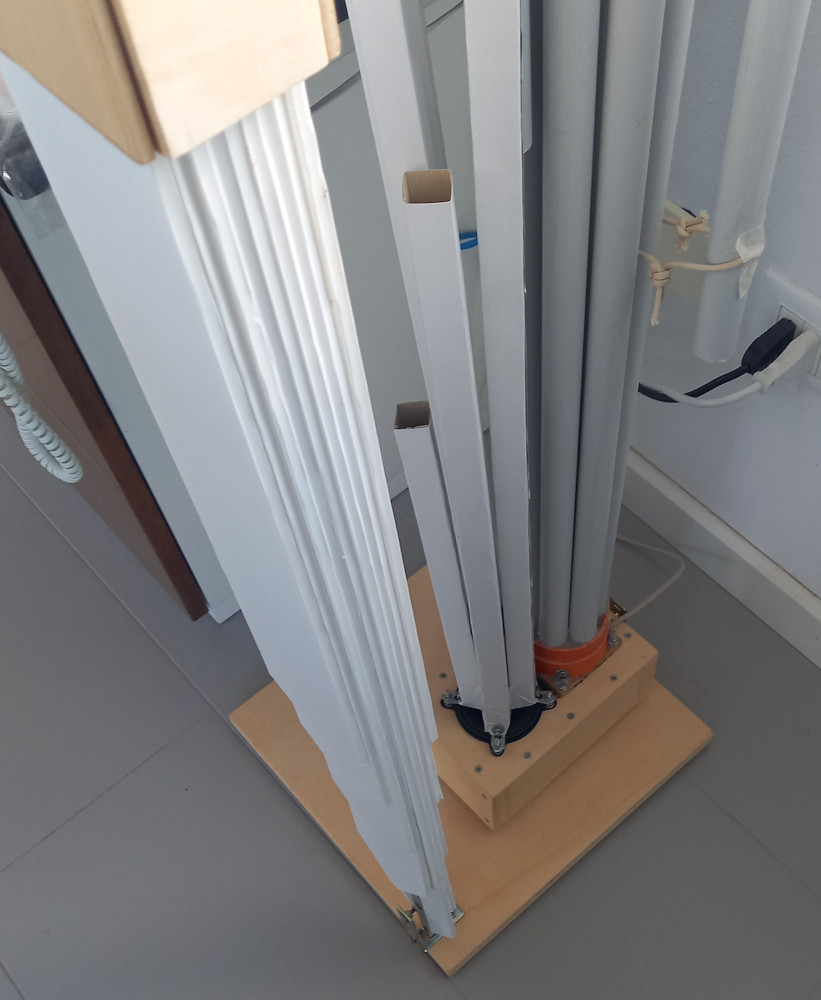 Il carico acustico frontale mddOmni del prototipo MDD3ZC350 V2 è realizzato con 5 guide d'onda rettangolari in cartoncino di lunghezza crescente, la serie ha Lmax = 8Lmin = 2000 mm, (379, 574, 871, 1320, 2000 mm). Le 5 guide sono disposte a croce e creano al loro esterno quattro ulteriori guide d'onda a 90 gradi aperte. L'emissione di ogni guida d'onda è omnidirezionale anche alle alte frequenze per il fenomeno della diffrazione acustica.
Il carico acustico frontale mddOmni del prototipo MDD3ZC350 V2 è realizzato con 5 guide d'onda rettangolari in cartoncino di lunghezza crescente, la serie ha Lmax = 8Lmin = 2000 mm, (379, 574, 871, 1320, 2000 mm). Le 5 guide sono disposte a croce e creano al loro esterno quattro ulteriori guide d'onda a 90 gradi aperte. L'emissione di ogni guida d'onda è omnidirezionale anche alle alte frequenze per il fenomeno della diffrazione acustica.
The mddOmni frontal acoustic load of the prototype MDD3ZC350 V2 is made with 5 rectangular cardboard waveguides of increasing length, the series has Lmax = 8Lmin = 2000 mm, (379, 574, 871, 1320, 2000 mm). The 5 guides are arranged in a cross and create four additional open 90 degree waveguides outside them. The emission of each waveguide is omnidirectional even at high frequencies due to the phenomenon of acoustic diffraction.
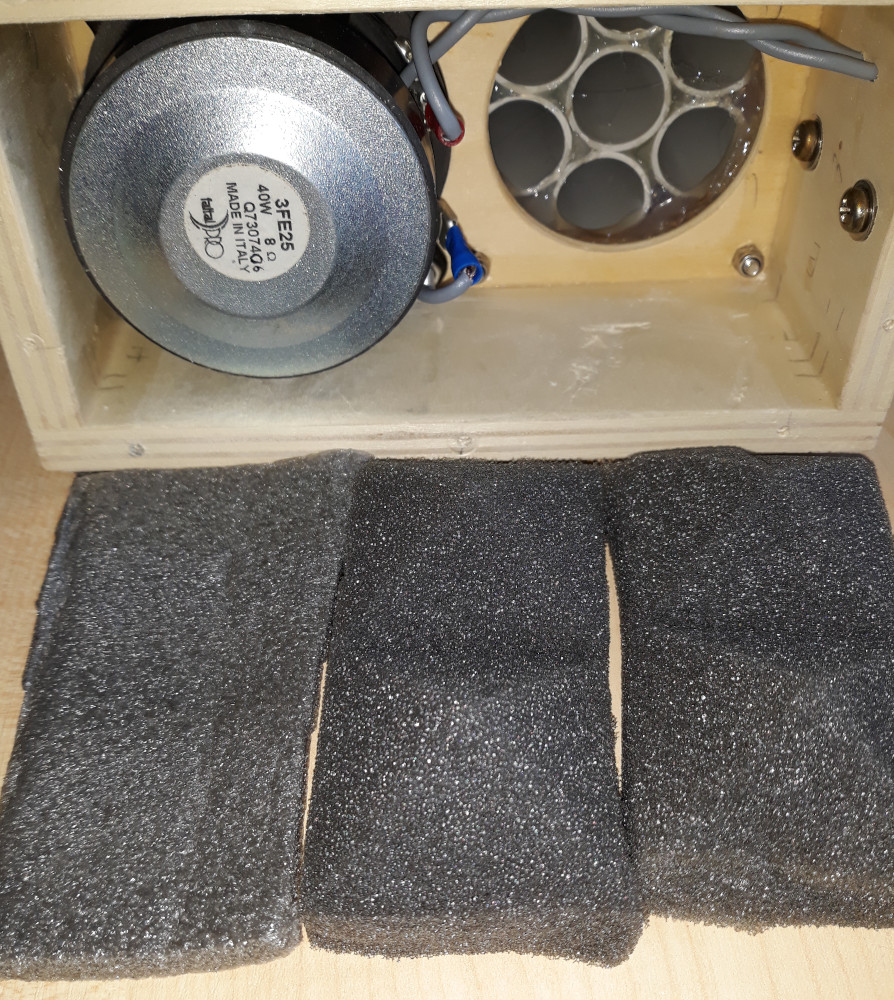
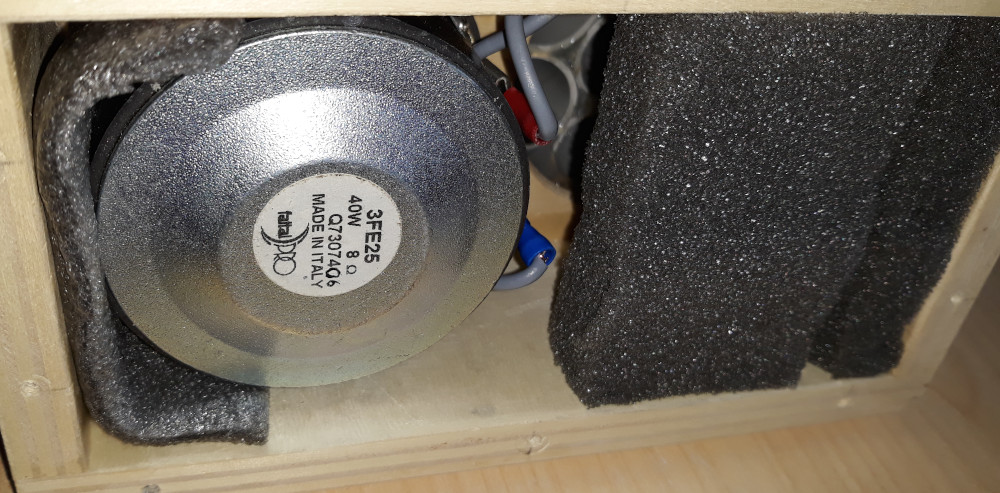 Nel prototipo MDD3ZC350 V2 il carico acustico posteriore mddTL è realizzato con 7 guide d'onda di lunghezza crescente, la serie ha Lmax = 2Lmin = 3400 mm (1877, 2072, 2288, 2526, 2789, 3079, 3400 mm). Le guide funzionano come linee di trasmissione multiple e hanno le prime frequenze di risonanza L/4 distribuite in modo omogeneo fra 25 e 45 Hz. Il volume interno della camera di compressione attiva anche le risonanze delle guide d'onda aperte ad entrambi i lati, le prime frequenze di risonanza L/2 sono distribuite in modo omogeneo fra 50 e 90 Hz. Le risposte in frequenza delle guide d'onda si sovrappongono in modo tale che l'energia acustica di tutte le frequenze superiori a 25 Hz possono essere trasferite in modo efficace dalla camera di compressione all'ambiente di ascolto. Il carico acustico posteriore mddTL attenua l'emissione alle alte frequenze.
Nel prototipo MDD3ZC350 V2 il carico acustico posteriore mddTL è realizzato con 7 guide d'onda di lunghezza crescente, la serie ha Lmax = 2Lmin = 3400 mm (1877, 2072, 2288, 2526, 2789, 3079, 3400 mm). Le guide funzionano come linee di trasmissione multiple e hanno le prime frequenze di risonanza L/4 distribuite in modo omogeneo fra 25 e 45 Hz. Il volume interno della camera di compressione attiva anche le risonanze delle guide d'onda aperte ad entrambi i lati, le prime frequenze di risonanza L/2 sono distribuite in modo omogeneo fra 50 e 90 Hz. Le risposte in frequenza delle guide d'onda si sovrappongono in modo tale che l'energia acustica di tutte le frequenze superiori a 25 Hz possono essere trasferite in modo efficace dalla camera di compressione all'ambiente di ascolto. Il carico acustico posteriore mddTL attenua l'emissione alle alte frequenze.
In the MDD3ZC350 V2 prototype the mddTL rear acoustic load is created with 7 waveguides of increasing length, the series has Lmax = 2Lmin = 3400 mm (1877, 2072, 2288, 2526, 2789, 3079, 3400 mm). The guides function as multiple transmission lines and have the first L/4 resonance frequencies homogeneously distributed between 25 and 45 Hz. The internal volume of the compression chamber also activates the resonances of the waveguides open on both sides, the first L/2 resonance frequencies are distributed homogeneously between 50 and 90 Hz. The frequency responses of the waveguides overlap in such a way that the acoustic energy of all frequencies above 25 Hz can be transferred into effectively from the compression chamber to the listening environment. The rear acoustic load mddTL attenuates the emission at high frequencies.
Nel prototipo 1a-direct il carico acustico posteriore mddTL le caratteristiche sono simili a quelle di una linea di trasmissione lunga circa un metro. In questo caso ho usato 9 pannelli in polipropilene alveolare da 5 mm incollati con all'interno un profilo in alluminio di 10 x 10 mm fissato alla base in legno del prototipo MDD3ZC350 V2. Le misure dei pannelli sono: 445, 481, 519. 561, 606, 654, 706, 763, 824, 890 mm. In totale ci sono circa 180 guide d'onda di lunghezza diversa con le rispettive risonanze che si compensano reciprocamente.
In the prototype 1a-direct the rear acoustic load mddTL the characteristics are similar to those of a transmission line approximately one meter long. In this case I used 9 5 mm honeycomb polypropylene panels glued with a 10 x 10 mm aluminum profile inside fixed to the wooden base of the prototype MDD3ZC350 V2. The panel sizes are: 445, 481, 519. 561, 606, 654, 706, 763, 824, 890 mm. In total there are approximately 180 waveguides of different lengths with their respective resonances compensating each other.
Ogni guida d'onda ha una propria risposta in frequenza con più risonanze dell'aria al suo interno, le frequenze cambiano con la lunghezza. L'ascolto non è penalizzato da questo effetto in quanto l'udito ha una sensibilità logaritmica alla pressioni acustica e le singole emissioni si sommano con le proprietà dei logaritmi. Se le risonanze sono distribuite distanziate e sovrapposte in modo opportuno la risposta in frequenza complessiva sarà regolare. La somma logaritmica delle pressioni sonora è utile anche per compensare reciprocamente due altoparlanti con risposte in frequenza diverse. Ascoltando il prototipo CL08A2 si percepisce una migliore risposta in frequenza rispetto ai singoli prototipi 1a-direct e MDD3ZC350 V2.
Each waveguide has its own frequency response with more resonances than the air inside it, the frequencies change with length. Listening is not penalized by this effect as hearing has a logarithmic sensitivity to acoustic pressure and the individual emissions add up with the properties of logarithms. If the resonances are distributed, spaced and overlapped appropriately, the overall frequency response will be regular. The logarithmic sum of the sound pressures is also useful for mutually compensating two speakers with different frequency responses. Listening to the CL08A2 prototype you can perceive a better frequency response compared to the individual prototypes 1a-direct and MDD3ZC350 V2.
supporto a risonanza subsonica - subsonic resonance support - home
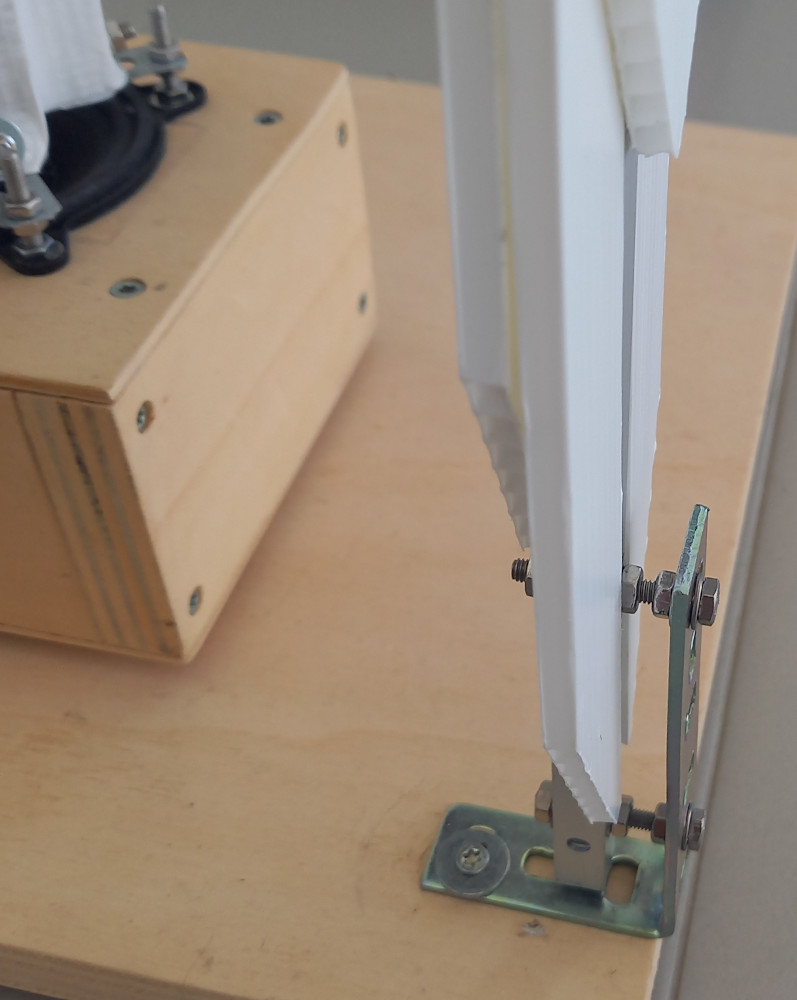
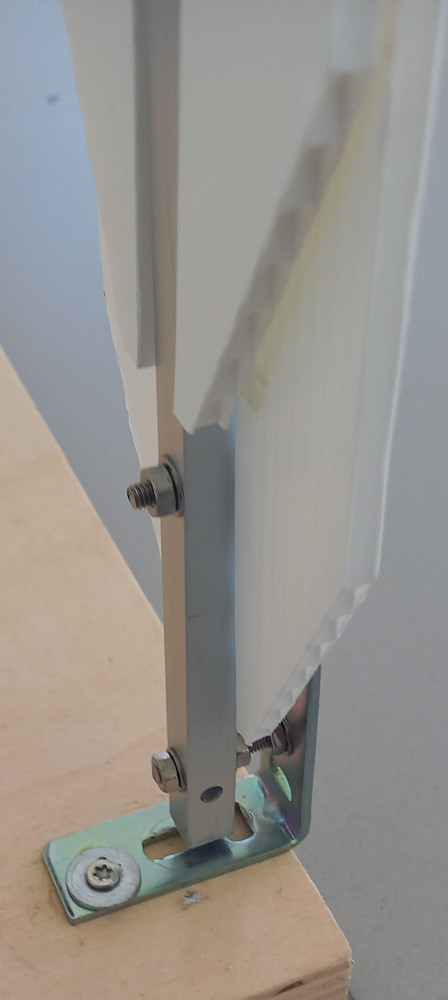

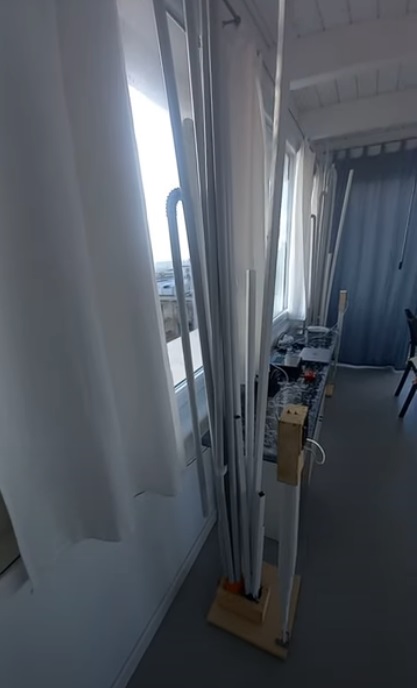 video
Il supporto a risonanza subsonica isola acusticamente la cassa acustica dal pavimento nella banda audio, evita interazioni indesiderate tra il pavimento e l'altoparlante. Il filmato mostra come oscilla il prototipo CL08A2, la frequenza è talmente bassa che si possono contare direttamente le oscillazioni.
video
Il supporto a risonanza subsonica isola acusticamente la cassa acustica dal pavimento nella banda audio, evita interazioni indesiderate tra il pavimento e l'altoparlante. Il filmato mostra come oscilla il prototipo CL08A2, la frequenza è talmente bassa che si possono contare direttamente le oscillazioni.
The subsonic resonance mount acoustically isolates the speaker from the floor in the audio band, avoiding unwanted interactions between the floor and the speaker. The video shows how the CL08A2 prototype oscillates, the frequency is so low that the oscillations can be counted directly.
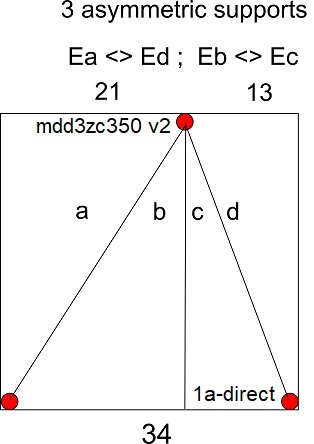 La base è un quadrato in compensato 20 x 340 x 340 mm. Ha tre piedini in gomma montati in modo asimmetrico, due sugli spigoli anteriori e uno sul lato posteriore a 210 e 130 mm dagli spigoli. La staffa a L del supporto subsonico del prototipo MDD3ZC350 V2 è fissata sopra il piedino posteriore. La staffa a L del supporto subsonico del prototipo 1a-direct è fissata sopra un piedino anteriore.
La base è un quadrato in compensato 20 x 340 x 340 mm. Ha tre piedini in gomma montati in modo asimmetrico, due sugli spigoli anteriori e uno sul lato posteriore a 210 e 130 mm dagli spigoli. La staffa a L del supporto subsonico del prototipo MDD3ZC350 V2 è fissata sopra il piedino posteriore. La staffa a L del supporto subsonico del prototipo 1a-direct è fissata sopra un piedino anteriore.
The basis is a plywood square 20 x 340 x 340 mm. It has three rubber feet mounted asymmetrically, two on the front edges and one on the rear side at 210 and 130 mm from the edges. The L-bracket of the subsonic support of the MDD3ZC350 V2 prototype is attached above the rear foot. The L-bracket of the subsonic support of the prototype 1a-direct is attached above a front foot.
Il progetto usa i prototipi 1a-direct e MDD3ZC350 V2, ogni canale ha due driver 3FE25 della Faital-Pro collegati in serie.
The project uses the 1a-direct and MDD3ZC350 V2 prototypes, each channel has two Faital-Pro 3FE25 drivers connected in series.
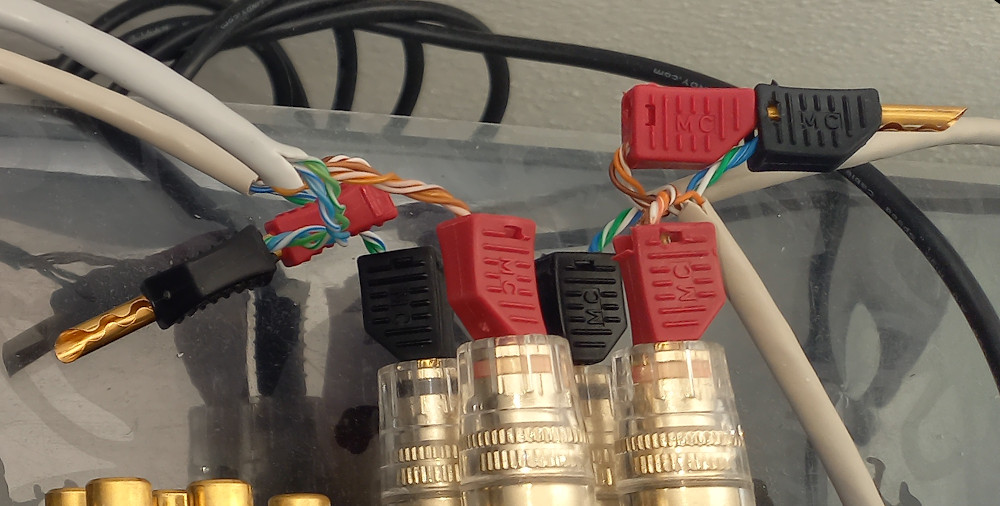
 Il collegamento in serie fa circolare la stessa corrente nei driver 3FE25 dello stesso canale. Le forze applicate ai coni degli altoparlanti sono proporzionali alla corrente elettrica che attraversa le bobine, quindi i driver saranno perfettamente sincronizzati.
Il collegamento in serie fa circolare la stessa corrente nei driver 3FE25 dello stesso canale. Le forze applicate ai coni degli altoparlanti sono proporzionali alla corrente elettrica che attraversa le bobine, quindi i driver saranno perfettamente sincronizzati.
Series connection circulates the same current in the 3FE25 drivers of the same channel. The forces applied to the speaker cones are proportional to the electric current flowing through the coils, so the drivers will be perfectly synchronized.
Con un collegamento parallelo l'amplificatore può controllare solo la tensione applicata alla maglia. A causa degli sfasamenti tensione-corrente, nella maglia stessa potrebbero generarsi correnti elettriche non compensate dall'amplificatore.
With a parallel connection the amplifier can only control the voltage applied to the loop. Due to voltage-current phase shifts, electric currents could be generated in the mesh itself which are not compensated by the amplifier.
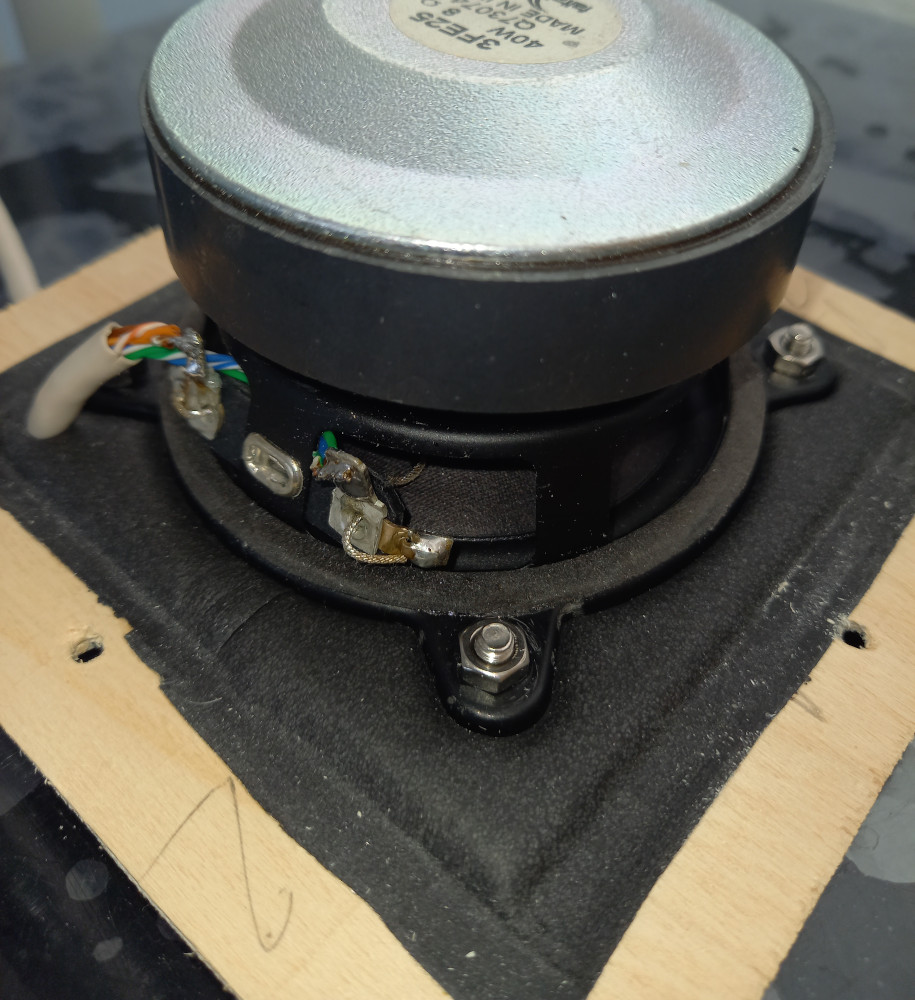
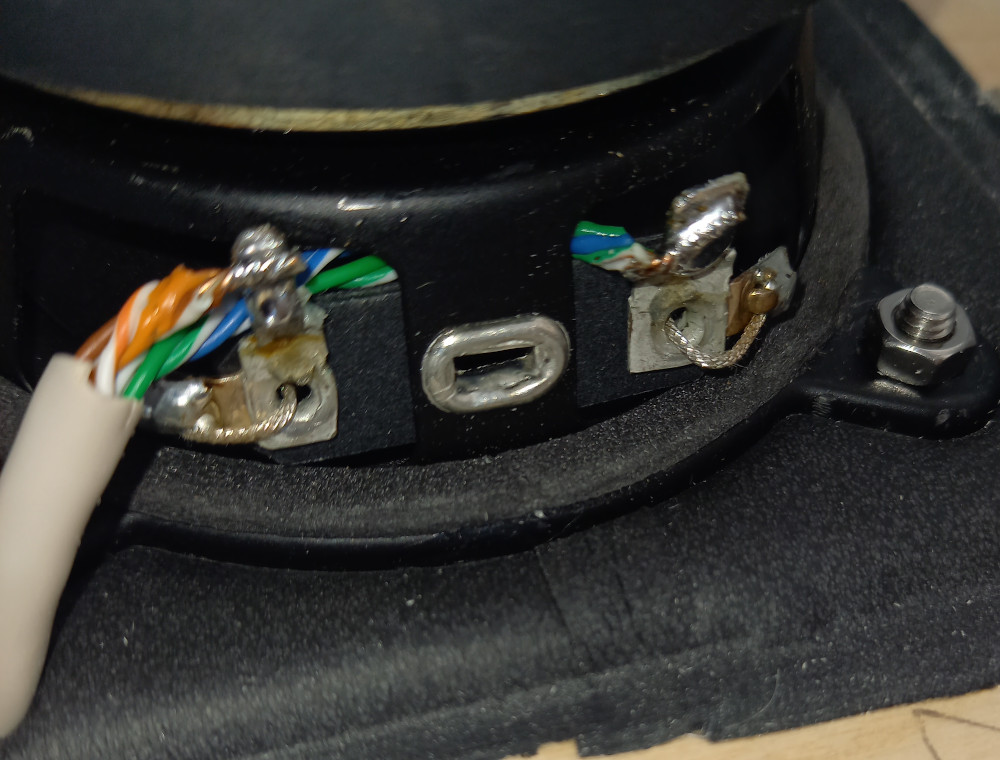 Il cablaggio usa cavo UTP cat5 in configurazione star-quad. Il polo positivo usa i fili: bianco-arancio, arancio, bianco-marrone, marrone. Il polo negativo usa i fili: bianco-blu, blu, bianco-verde, verde. Le connessioni sono saldate direttamente sui poli del driver. Il polo negativo passa all'interno del cestello per evitare che il raggio in materiale ferromagnetico attivi fenomeni di isteresi che aumentano la distorsione.
Il cablaggio usa cavo UTP cat5 in configurazione star-quad. Il polo positivo usa i fili: bianco-arancio, arancio, bianco-marrone, marrone. Il polo negativo usa i fili: bianco-blu, blu, bianco-verde, verde. Le connessioni sono saldate direttamente sui poli del driver. Il polo negativo passa all'interno del cestello per evitare che il raggio in materiale ferromagnetico attivi fenomeni di isteresi che aumentano la distorsione.
The cabling uses cat5 UTP cable in star-quad configuration. The positive pole uses wires: white-orange, orange, white-brown, brown. The negative pole uses wires: white-blue, blue, white-green, green. The connections are soldered directly onto the driver poles. The negative pole passes inside the basket to prevent the ferromagnetic material beam from activating hysteresis phenomena which increase distortion.